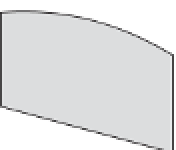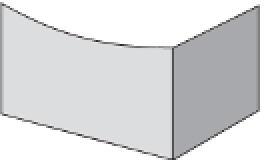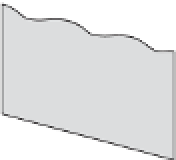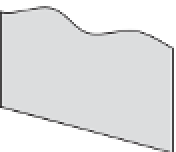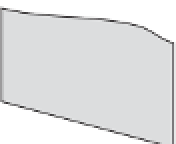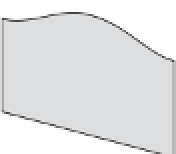Geology Reference
In-Depth Information
isolated tower, a jagged peak, or a rounded hill, depend-
ing on the caprock thickness. In
stepped topography
,
scarps display a sequence of structural benches, produced
by harder beds, and steep bluffs where softer beds have
been eaten away (see Colour Plate 10, inserted between
pages 208 and 209).
from other directions. Domes are also termed
periclines
.
An example is the Chaldon pericline in Dorset, England,
in which rings of progressively younger rocks - Wealden
Beds, Upper Greensand, and Chalk - outcrop around
a core of Upper Jurassic Portland and Purbeck beds.
Domed structures also form where the crust is thrust
upwards, although these forms are usually simpler than
those formed by more complex pressure distributions.
Domes are found, too, where plugs of light material,
such as salt, rise through the overlying strata as
diapirs
.
Folds may be symmetrical or asymmetrical, open or
tight, simple or complex. Relief formed directly by folds is
rare, but some
anticlinal hills
do exist. The 11-km-long
Mount Stewart-Halcombe anticline near Wellington,
New Zealand, is formed in Late Pleistocene sediments
of the coastal plain. It has an even crest, the surfaces of
both its flanks run parallel to the dip of the underlying
beds (Box 5.1), and its arched surface replicates the fold
(Ollier 1981, 59). Even anticlinal hills exposed by ero-
sion are not that common, although many anticlinal hills
in the Jura Mountains remain barely breached by rivers.
The commonest landforms connected with folding
are
breached anticlines
and
breached domes
. This is
because, once exposed, the crest of an anticline (or the
top of a dome) is subject to erosion. The strike ridges on
Folded beds
Anticlines
are arches in strata, while
synclines
are
troughs (Figure 5.13). In
recumbent anticlines
, the beds
are folded over.
Isoclinal folding
occurs where a series
of overfolds are arranged such that their limbs dip in
the same direction.
Monoclines
are the simple folds in
which beds are flexed from one level to another. An
example is the Isle of Wight monocline, England, which
runs from east to west across the island with Creta-
ceous rocks sitting at a lower level to the north than
to the south. In nearly all cases, monoclines are very
asymmetrical anticlines with much elongated arch and
trough limbs. Anticlines, monoclines, and synclines form
through shearing or tangential or lateral pressures applied
to sedimentary rocks.
Domes
, which may be regarded as
double anticlines, and
basins
, which may be regarded
as double synclines, are formed if additional forces come
()Anticline
a
( ) Syncline
b
()Asymmetrical folding
c
(
d
) Monocline
( ) Isoclines
e
( ) Recumbent fold
f
()Dome
g
()Basin
h
Figure 5.13
Structures formed in folded strata.
